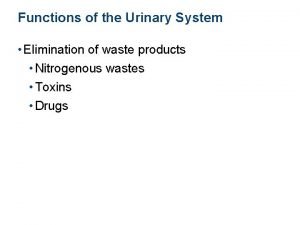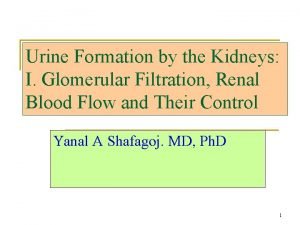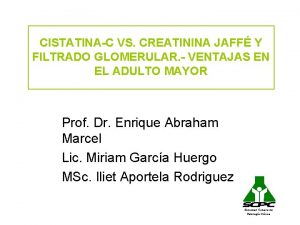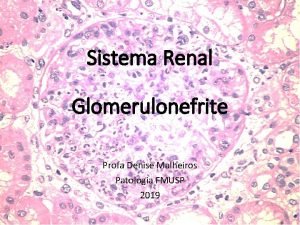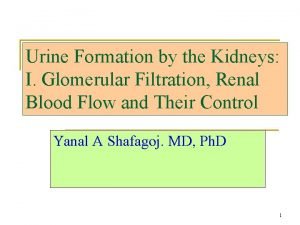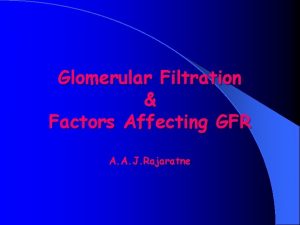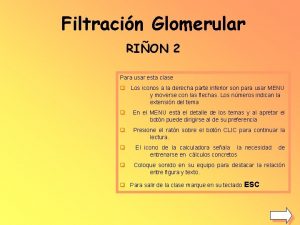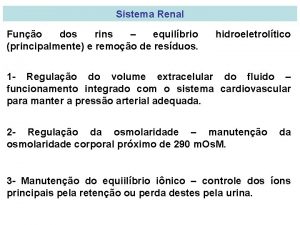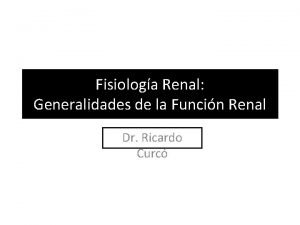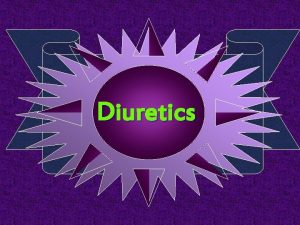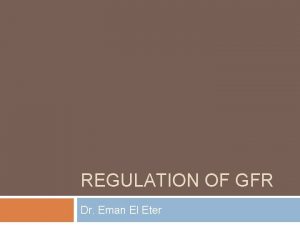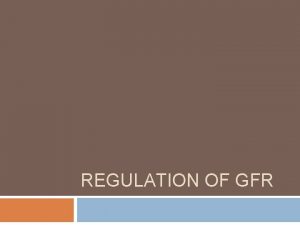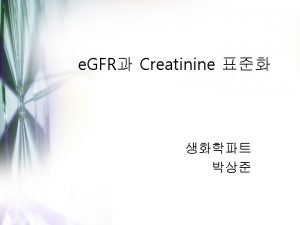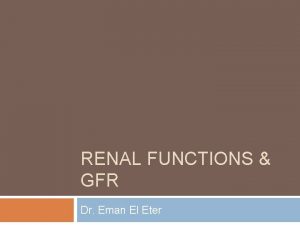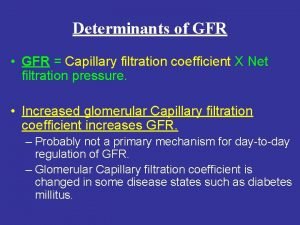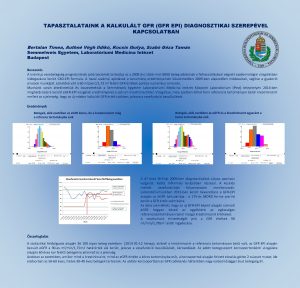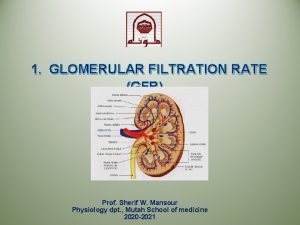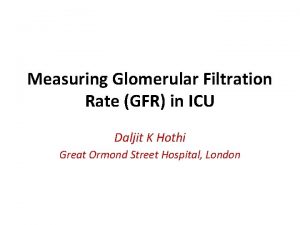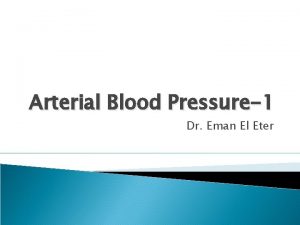REGULATION OF GFR Dr Eman El Eter Glomerular


















- Slides: 18

REGULATION OF GFR Dr. Eman El Eter

Glomerular Filtration Rate (GFR) Defined as: The volume of filtrate produced by both kidneys per min Averages 125 ml/min Totals about 180 L/day (45 gallons) So most filtered water must be reabsorbed or death would ensue from water lost through urination GFR is directly proportional to the NFP An increase in NFP A decrease in NFP GFR Changes in GFR normally result from changes in glomerular blood pressure. NFP = net filtration pressure

GFR = 125 ml/min 180 L /day 1% excreted

Why is it important to have the GFR regulated?

Regulation of GFR Glomerular Filtration Rate If the GFR is too high: Fluid flows through tubules too rapidly to be absorbed Urine output rises Creates threat of dehydration and electrolyte depletion If the GFR is too low: Fluid flows sluggishly through tubules Tubules reabsorb wastes that should be eliminated Azotemia develops (high levels of nitrogencontaining substances in the blood).

Regulation of GFR controlled by adjusting glomerular blood pressure through the following mechanisms: - Autoregulation - Sympathetic control - Hormonal mechanism: renin and angiotensin

Effect of Arterial BP on GFR ↑↑ ABP → ↑↑ GFR. However, the body maintains constant GFR over an ABP range of 75 -160 mm. Hg. Why? And how?

AUTOREGULATION OF GFR • GFR remains constant over a large range of values of BP • 75 -160 mm. Hg

How autoregulation takes place?

Auto-regulation of GFR Refer to feedback mechanisms intrinsic to the kidney that keep the renal blood flow and GFR relatively constant despite fluctuations in ABP. These mechanisms operate over an ABP ranging between 75 -160 mm. Hg. Achieved by 2 major mechanisms: 1. 2. Myogenic auto-regulation. Tubulo-glomerular feedback mechanism.

Tubulo-glomerular Feedback Release Renin ↓↓ Na. Cl Vasodilation of afferent arteriole Juxtaglomerular cells ↑↑ GFR Angiotensinogen II Vasoconstriction of Efferent arteriole

Mechanism of autoregulation Tubuloglomerular feedback mechanism: ABP delivery of Na. Cl to the macula densa cells, which are capable of sensing this change , this will cause two effects: 1 - decrease in resistance of the afferent arterioles (i. e. vasodilatation) glomerular hydrostatic pressure to normal levels. 2 - increase in renin release from JG cells Ang II constrict efferent arteriole glomerular hydrostatic pressure & GFR to

Mechanism of autoregulation, cont……. Myogenic mechanism: It is the intrinsic capability of blood vessels to constrict when blood pressure is increased. The constriction prevents excess increase in renal blood flow and GFR when blood pressure rises. When blood pressure decreases the myogenic mechanism reduces vascular resistance and the vessel dilates.

Example of autoregulation

Hormonal Control of GFR -efferent arterioles

Effects of Angiotensin II

Sympathetic Control of GFR (Extrinsic) When the sympathetic nervous system is at rest: Renal blood vessels are maximally dilated Autoregulation mechanisms prevail Under stress: Norepinephrine is released by the sympathetic nervous system Epinephrine is released by the adrenal medulla Afferent arterioles constrict and filtration is inhibited Note: during fight or flight blood is shunted away from kidneys The sympathetic nervous system also stimulates the renin-angiotensin mechanism. This induces vasoconstriction of efferent arteriole.

Thank you
 Eman nayyab
Eman nayyab Eman güvenlik
Eman güvenlik Chapter 15 urinary system
Chapter 15 urinary system External urethral orifice
External urethral orifice Autoregulation of gfr
Autoregulation of gfr Glomerular filtration
Glomerular filtration Filtrado glomerular formula korotkoff
Filtrado glomerular formula korotkoff Filtração glomerular fisiologia
Filtração glomerular fisiologia Prostagalndins
Prostagalndins Arteriola aferente e eferente
Arteriola aferente e eferente Glomerulo netter
Glomerulo netter Peritubular
Peritubular Factors affecting gfr
Factors affecting gfr Hematuria glomerular y extraglomerular
Hematuria glomerular y extraglomerular Filtracin
Filtracin Fisiologia do sistema renal
Fisiologia do sistema renal Formacion de la orina
Formacion de la orina Nephron
Nephron Hydrochlorthiaside
Hydrochlorthiaside



